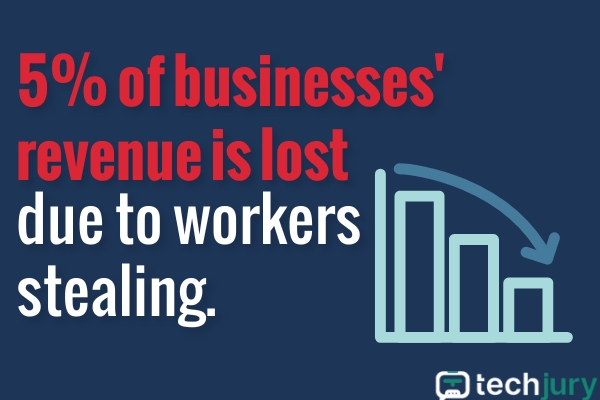

Updated · Feb 11, 2024
Updated · Jan 02, 2024
With a master's degree in telecommunications and over 15 years of working experience in telecommunic... | See full bio
April is a proficient content writer with a knack for research and communication. With a keen eye fo... | See full bio
Dr. Edward Marchewka is a seasoned executive that has come up through the ranks in the IT vertical, ... | See full bio
Employee theft is unfortunately common among businesses. It can range from taking away extra snacks from the office pantry to full-on by your regular office glutton to large-scale fraud from Wall Street tycoons.
In general terms, employee theft is the unauthorized taking, transfer, or use of the property of your organization. Employee theft is at its peak, as about 75% of employees have admitted to stealing from their employer at least once.
Currently, 95% of workplaces face huge employee theft issues. If you're managing an office, you should know the following stats.
|
Editor’s Choice
|
Every US adult tells an average of 1 to 2 lies daily. With our expanding reliance on digital tools, fraud is on the rise. However, employees don’t just steal or commit fraud because they can.
Renowned criminologist Donal Cressey theorized that individuals tend to commit fraud based on three factors:
|
There are many reasons why bottom-feeder employees and even CEOs steal or commit fraud. Let’s check out the latest stats!
(Finances Online)
Investing in people is perhaps one of the most important decisions you’ll have to make as a business owner. Most of the time, you can only hope you’ve made the right choice.
About 75% of employees have stolen from their employer at least once, and over 37.5% have reported stealing at least twice.
There are many ways for companies to deter stealing and fraud. They should prioritize establishing a culture of honesty and integrity and implement strong internal control measures.
(Embroker)
Isn’t that neat? The people you trust with your money are the ones who steal from you.
Employee theft statistics also show that more than half of people would steal from their businesses if they knew they wouldn’t be caught.
Deterring fraud from the people who handle your books isn’t easy. However, companies can remedy this by closely monitoring financial transactions, conducting audits regularly, and ensuring sufficient insurance coverage.
(Exploding Topics)

Businesses lose roughly 5% of their revenue due to workers stealing. Workers can steal money, falsify travel or reimbursement documents or steal physical property.
Employee theft places a heavy toll on US businesses, and the most brutal hit are small businesses, often unaware of internal perpetrators.
Theft is a business risk, as employers can incur dire financial losses. Those who are caught stealing can also face serious legal consequences. They may also be penalized for gross misconduct, demotion, and even termination.
(CompareCamp)
Most employees have been stealing for years. Many continue with it in any organization or business enterprise they find themselves in, as it has become part and parcel of them.
On average, it takes five years before a thieving employee is caught. It takes a long time to catch thieving employees since some steal such small amounts that it doesn’t even raise a red flag. Some don’t even realize they’ve committed theft at all.
(Embroker)
A third of all business bankruptcies in the United States are due to employee theft. Overall, this amounts to $50 billion annually.
Some of the biggest bankruptcies are due to massive fraud by their executives. In 2020, Germany-based Wirecard filed for insolvency. However, a fraud investigation showed that $2.1 billion was missing from the company’s books.
As the biggest corporate fraud case in German history, its CEO and former top executives face multiple years in prison. Investors face little hope of ever recovering their money.
|
Fraud can happen anytime and be committed by anyone. However, some are more likely to commit them than others. From a corporate perspective, employee theft is typically done for personal gain or a desire to mislead shareholders and investors.
In the past few years, government agencies, forensic accountants, and external auditors launched a massive effort to combat theft and fraud.
However, many fraud and theft cases still get through intense scrutiny by these institutions. Let’s check out the stats!
(Embroker)
Men are more likely to commit fraud. Specifically, well-educated men in their 30s to 40s are primary perpetrators of white-collar crimes.
A quick look at some of the biggest financial scandals worldwide shows that men are allegedly at the forefront of financial fraud. Some of the most notorious cases are:
It’s unclear why these are the most common demographics for fraud. However, it may concern their financial positions, network, and overall company influence.
(Embroker)
Employee theft statistics show that 34% of millennials justify stealing from their employers. It’s logical to assume they will likely be the number one offenders too. However, studies show that the average age of your company thief is 48.
O top of that, they are usually middle-aged people belonging to middle-class families. Some admit financial gains as their motive.
About 48% of Americans in that same age group admit they won't be able to "survive" in retirement because of a lack of funds. Other reasons could include:
Most perpetrators also act alone. However, others work together to circumvent systems in place mean to deter fraud within companies.
|
👍 Helpful Articles: While this may seem shocking, millennials are also 25% more likely to report frauds and scams, at least compared to those 40 and above. Unfortunately, scams abound, especially in the golden age of the internet. Protect yourself from fraudulent transactions by reading through some of our helpful articles. |
(JW Surety Bonds, Stonebridge)
This is another surprising number that makes it tougher to predict who would steal from you and why, but also one of the reasons why you must investigate someone before hiring them.
Roughly 83% of people who commit fraud have never been terminated from a job or punished before committing fraud. This occurrence may likely be because cases are rarely reported to law enforcement. Others may also enter into confidential settlement agreements.
Conducting thorough background checks on applicants before hiring can’t be over-emphasized, as it helps mitigate the occurrence of these nefarious activities.
|
✅ Pro Tip: If you suspect someone is committing fraud, you can quickly investigate them using top-reviewed background checkers. While you legally can’t use these to discriminate against employees, especially during the hiring process, this can give you an idea of how this person has conducted themselves in the past. |
(CompareCamp)
High school and university graduates are included in the list of employee theft demography. The steady rise in employee theft statistics within all age brackets makes it paramount to put all the necessary measures to checkmate these criminal acts.
There are many types of theft employees can commit. Cases include, but are not limited to:
Keeping a keen eye on employees showing signs of fraud can help deter and catch fraud cases and identify potential risks.
(ACFE & Zippia, My Educator)
Workplace theft statistics show that skimming costs a company $2,900 monthly, on average. The median monthly losses for check and payment tampering sit at $4,600. Corruption follows at $11,100, noncash at $6,000, and billing at $4,200.
Motivations for financial statement fraud vary on a case-to-case basis. However, a common theme in many fraud and employee theft cases are:
Many companies issuing fraudulent financial statements involve having executives who own considerable amounts of stocks or stock options. If stock prices were to go down, their personal net worth would significantly decrease.
Furthermore, if they want more people to invest, they must keep their financial statements promising.
(ACFE)
In many ways, the workplace is a den of thieves. Taking home a paperclip or a stapler may not sound like a crime, but technically it is. However, some departments are just more likely to steal compared to others.
The Association of Certified Fraud Examiners (ACFE) cites the following departments as the most sticky-fingered groups within companies:

Nothing too surprising here. The easiest way to hide money before being accounted for is by logging them in beforehand.
(JW Surety Bonds)
When asked why they stole, most said they could escape it. Most of these cases involve intellectual theft.
This theft involves stealing secrets, ideas, creative works, expressions, or inventions from an individual or organization. People think stealing ideas or creativity isn’t that big of a deal. Yearly, 34% of businesses worldwide suffer from insider threats, a type of intellectual theft.
However, at the bottom line, intellectual theft undermines a company's economic growth and stifles innovation.
Unsurprisingly, data breach accidents like hacking usually involve IT department personnel since they can access sensitive information.
(JW Surety Bonds)
These retail theft statistics are far from optimistic. Employees steal clothes, food, cosmetics, tech gadgets, and more.
In America, employee theft accounts for 43% of lost revenue. It costs retailers nearly half of their reported lost revenue.
Certain stores tend to experience employee theft more often than others. Discount stores report higher employee theft numbers than supermarkets or home improvement stores.
Employee theft is a grave crime, and while the consequences of employee theft are severe, these people do not seem discouraged.
(CompareCamp)
Even using the printer for personal reasons counts as employee theft.
Scissors, pens, markers, notebooks, and sticky notes disappear regularly. They continue with this as they assure themselves that the supply is replenished when due. This act has led to extra millions of dollars in expenses annually.
|
🎉 Not-So-Fun Fact: A Texas man was caught after stealing fajitas for nine years. What started as a side hustle for the defendant, Gilberto Escamilla, snowballed into a retail value of $1.2 million of meat. Escamilla, who worked at Cameron County Juvenile Detention Center, was sentenced to fifty years for first-degree felony. His sentence was also harsher than regular employee theft because theft by a public servant is a more egregious crime in Texas. |
Many theft cases may have already been happening for years. However, there are some behavioral red flags that companies can look out for in possible fraud cases, such as:
Before giving you the know-how, here are a few statistics on employee theft prevention worth sharing of.
Read on to find out!
(ACFE)
Half of the time, workplace theft charges are resolved by conscientious employees. Another 22% of tips come from customers.
Employees are less likely to steal from you if you have a good relationship with them. If it happens, the loyal ones will let you know.
(ACFE)
Here’s another recommendation: keep up to date with your internal audits. Don’t warn anyone about them. Check bank statements, inventory, and cameras.
Internal auditors can detect fraud by conducting audits, reviewing transactions, and analyzing data. They can help businesses to prevent further fraud and minimize the financial impact of any incidents by identifying suspicious activity and investigating potential fraud cases.
(ACFE)
People are less likely to steal if a boss is involved in the company dynamic. One-on-one meetings are an excellent way to see if there are any issues. Reviews are also very beneficial.
Make sure your company has clear policies. Protect sensitive data and don’t give many people access to it. Try to set a good example and be as present as possible. As earlier discussed, an employee wouldn’t commit a crime if they knew they’d get caught.
Good employee monitoring software will make the whole job a lot easier.
Workplace theft is no joke. It can lead to dire consequences, both financially and legally. Using the company printer is, in hindsight, harmless. However, most other issues can lead to money losses or even bankruptcies.
The good news is that it can be avoided if employers and workers practice honesty and integrity.
75% of employees have stolen at least once, and 95% of companies have suffered from employee theft.
US businesses lose around $50 billion annually. Some even go bankrupt because of it. While no bulletproof method exists to avoid this, you can always get cameras, install proper software, and be careful with who you hire.
That remains a mystery. Some people need more money or resources. Some might do it for the thrill.
If you don’t catch one thief, you can expect more thieves. Employee theft can be contagious within the workplace and lower productivity levels.
Your email address will not be published.
Updated · Feb 11, 2024
Updated · Feb 11, 2024
Updated · Feb 08, 2024
Updated · Feb 05, 2024



